SEO
Event Link Building: A Beginner’s Guide
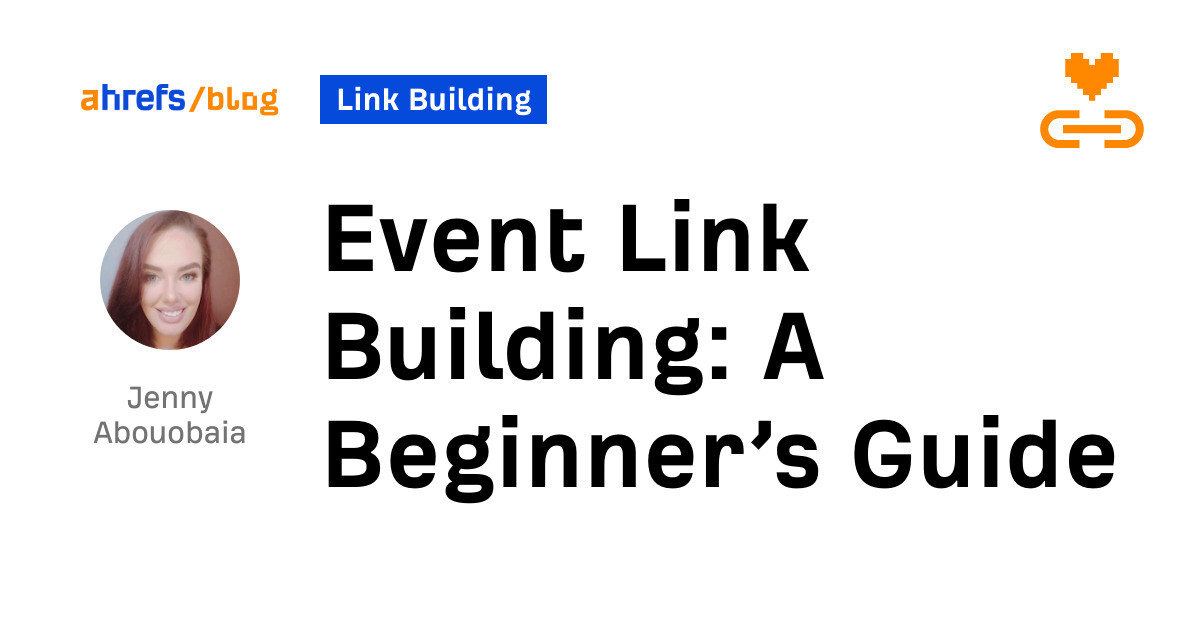
When it comes to acquiring high-quality backlinks, SEOs are always looking for new and innovative ways to land killer links that their competitors can’t easily replicate. Event link building is a unique way to do exactly that.
Building event links is relatively easy. But it can be difficult for beginners, as it requires an understanding of SEO and event planning in some cases. In this article, we will look at event link building and how to get started in six easy steps.
Event link building is all about getting links to your website by participating in local, national, or global events. These links can be obtained in two ways, either by hosting an event or sponsoring one.
As an event host, you can obtain links from third-party event sites like Eventbrite, blogs, and press. These sites are designed to feature both in-person and online global events like conferences and seminars.
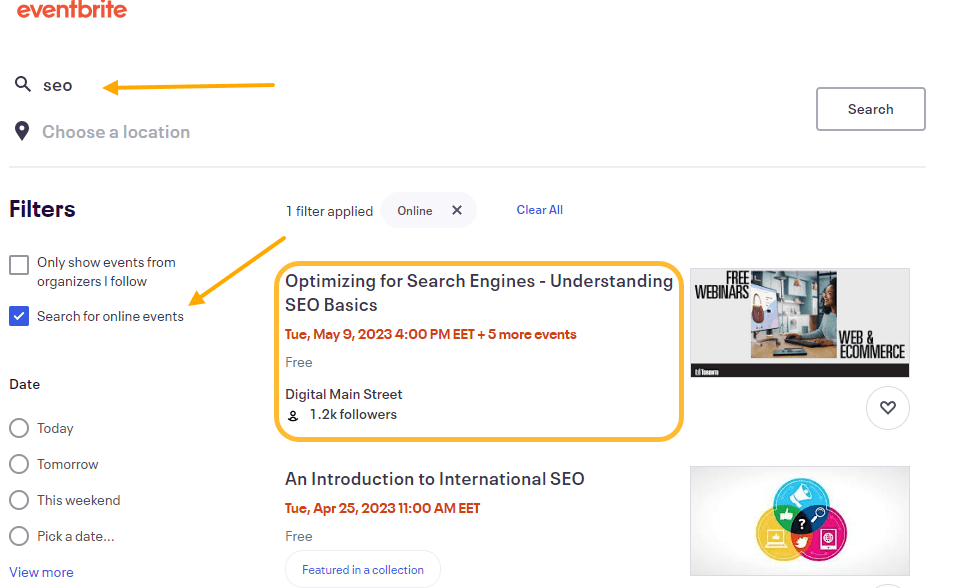
By sponsoring events, you can earn a link to your website from the event site itself.
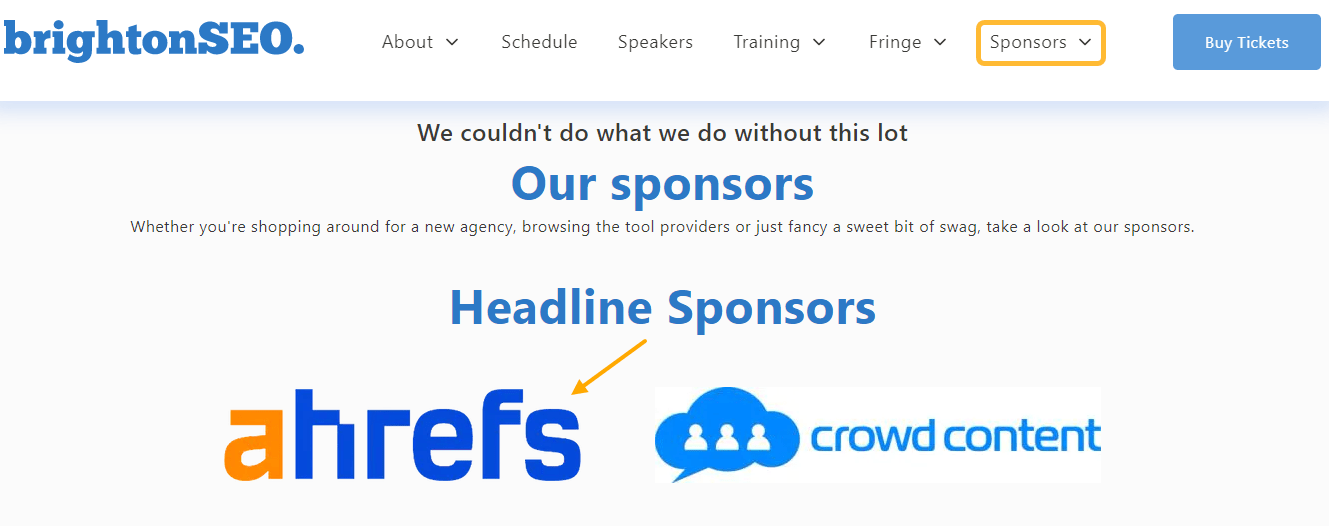
Not only are event links earned, making them “Google-approved,” but they are also highly relevant (topically but also geographically if you’re the event host).
Building event links is a powerful strategy for improving search engine rankings, diversifying your backlink profile, and promoting brand awareness.
Event link building allows you to build super high-quality links from not only the biggest names in your industry but also editorial links from local and national press.
This will improve your website’s perceived authority (with both competitors and Google). Also, event links offer diversity more than traditional link building techniques like guest blogging.
You can also boost your local SEO game by hosting or sponsoring geographically relevant events. Acquiring links from local companies, venues, and press can significantly improve your rankings for local queries.
Hosting an event is one of the best link building strategies. However, it takes a lot of preparation, planning, time and, of course, money.
A much easier (but just as powerful) way to build event links is through event sponsorships.
Sponsoring different types of events depends on your industry. The following are some examples of events that may work for you:
- Concerts
- Associations or clubs
- Event meetups
- Conferences
- Seminars and workshops
- Training seminars
- Sporting events
- Various academic events and lectures
Of course, to get started, you will need to both find and vet potential events to see if they are worth investing your time and money into. There are two things you can do to find great events to sponsor.
First, you can start by focusing on industry-specific events. There’s no doubt you are already familiar with several of the most popular events in your industry. Some good examples for our industry are brightonSEO and SaaStr.
Most events will have a page dedicated to sponsors where you can register to sponsor an upcoming event. Here’s an example from the Engage conference (formally SearchFest).

As you most likely already have an understanding of the quality and expected attendance of these events, it cuts down on the time needed to find and vet them.
However, do note that sticking only to popular events in your industry will limit the number of high-quality event links you can acquire for your website.
So you’ll want to start looking to sponsor events that may be outside the scope of your industry. These may fall into some of the categories listed above (such as concerts or sporting events) that are happening locally.
The easiest way to find these is to use Google with search operators. For example, to find different events happening in your area, you can use (events AND football club) Newcastle Upon Tyne.
With Ahrefs’ SEO Toolbar, you can see metrics for each resulting website right in Google search, including the Domain Rating, referring domains, and organic traffic. This can help you to quickly vet potential websites and see which are worth looking into further.
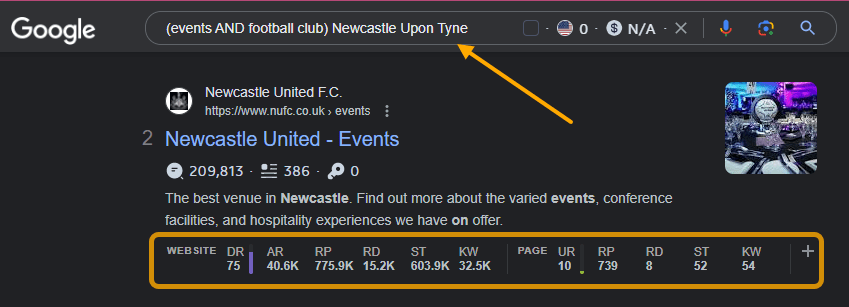
Remember, the goal is to build links from quality events. Don’t look to sponsor just anything and everything. A popular event will have more people linking to it, increasing link equity. Look for events that are already popular with:
- The media.
- Influencers and bloggers.
- Your target audiences/customers.
- Other industry leaders.
One quick pro tip: be sure to add a “sponsored events” page to your own website.
This should list the events you sponsor. Do include a section below informing visitors of the types of events you are willing to sponsor and contact details for event organizers looking for sponsorship.
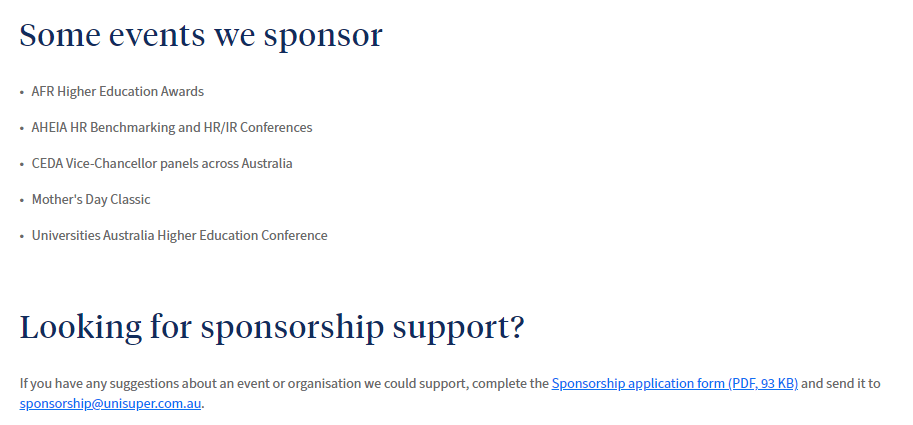
This is a great way to bring you relevant events and save time researching further events.
Although sponsoring events takes the hassle out of planning and running an event, hosting events is a great way to get your name out in your industry.
It builds brand awareness (and links) and can also help relay your values and mission to your audience. For example, by hosting local charity events, you can show that your company is philanthropic and cares about the community.
You don’t have to be a huge brand with unlimited funding to host events. Even small businesses and “solopreneurs” can host small local events to earn awesome links from local companies and the press.
Here are some tips on how you can go the extra mile to promote your events to ensure they acquire as many high-quality links as possible.
1. List events on your website
Create an events page on your website dedicated to any upcoming events you are hosting.
Be sure to list all the events with all the relevant information, including who or where to get in touch for tickets. Getting the searcher to register is the next step after getting the initial click from the SERP.
Your event page should include the following key details:
- Title of the event
- Description of the topics covered
- Venue of the event
- Full event schedule
- List of prominent figures such as speakers for conferences or judges for competitions
- Provide attendees with a compelling reason to attend
- Proof from social media
- Effective call to action
2. Implement event schema on all listings
When searching for “events near me,” Google search will display the relevant results. Some rich results in the SERPs show relevant information, including the event’s location, date, and time.
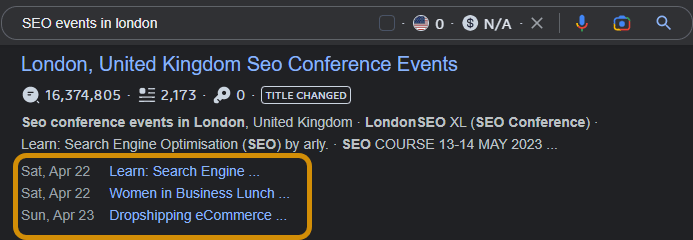
By adding code to your event page, you can organize your webpage content and add specific details about your event using Google’s event structured data markup.
Not only does implementing event schema allow your events to be eligible for display on Google’s event experience, but it also increases the chance of your event being discovered.
In fact, Google states that through event structured data, “Eventbrite saw a 100% increase in the typical year-over-year growth of traffic from Google Search.”
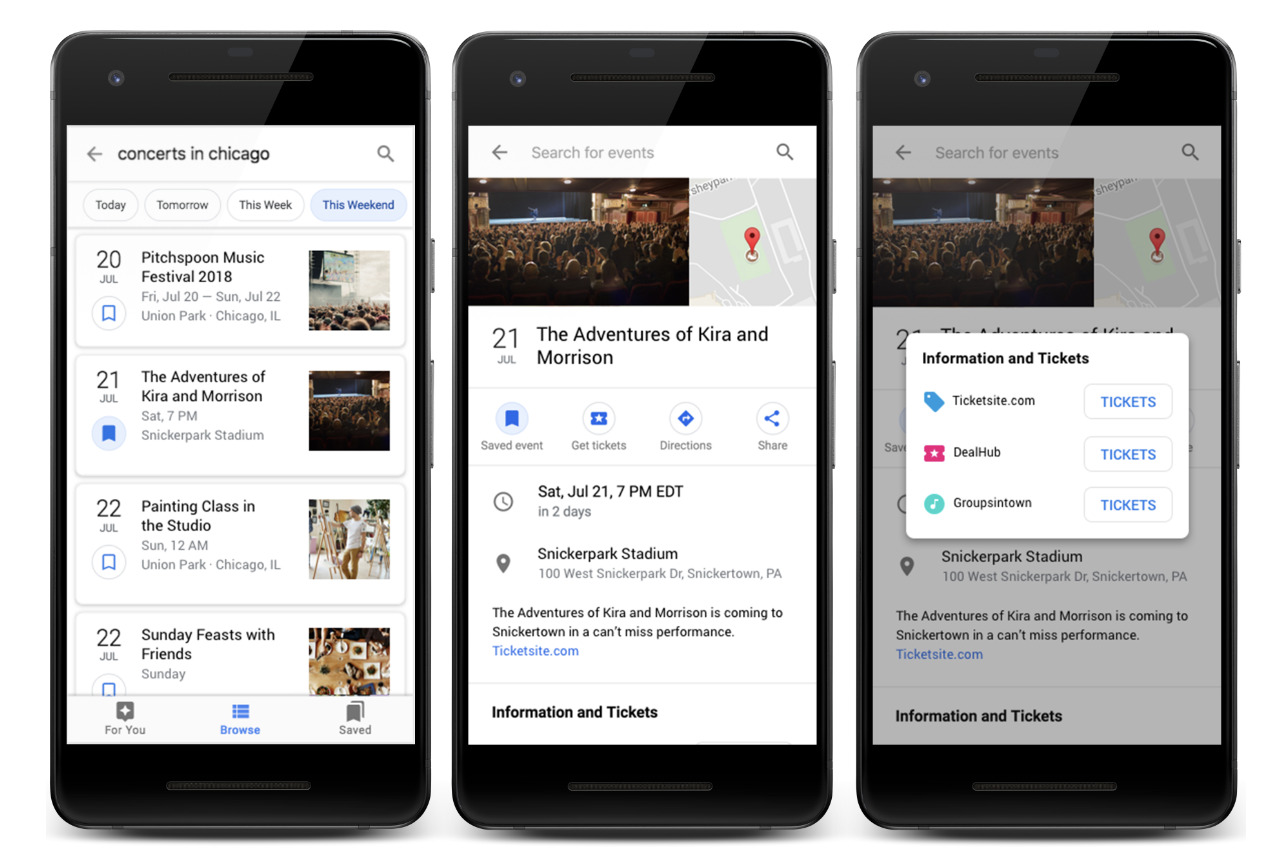
Your events page should include an event schedule that can be shown in Google’s event experience to drive registration.
There are a number of ways to implement structured data. If you’re using WordPress as your CMS, the Event Schema WordPress plugin is the quickest and easiest way to add event schema to your site.
If you’re not using WordPress, you can also use Google’s Data Highlighter to mark up your pages.
3. Add listings to third-party event sites
Most event organizers only list their events on bigger platforms like Eventbrite. Needless to say, this is not the only event website out there.
Sites like brownpapertickets.com, petaluma360.com, punchbowl.com, and more all host event listings.
Note that most third-party sites already have schema built into their listings, so you don’t need to worry about it for these sites.
4. Craft an effective outreach strategy
Once your events are listed and ready to be promoted, you need to develop an effective outreach strategy.
Find bloggers, websites, and social media influencers who may be interested in your event.
You can use Ahrefs’ Content Explorer to find and reach out to websites and authors who are likely to promote your event.
For example, to identify people writing about SEO events, you can enter something like "SEO" AND ("conferences" OR "events"). Use the “In title” path to only show the most relevant pages.
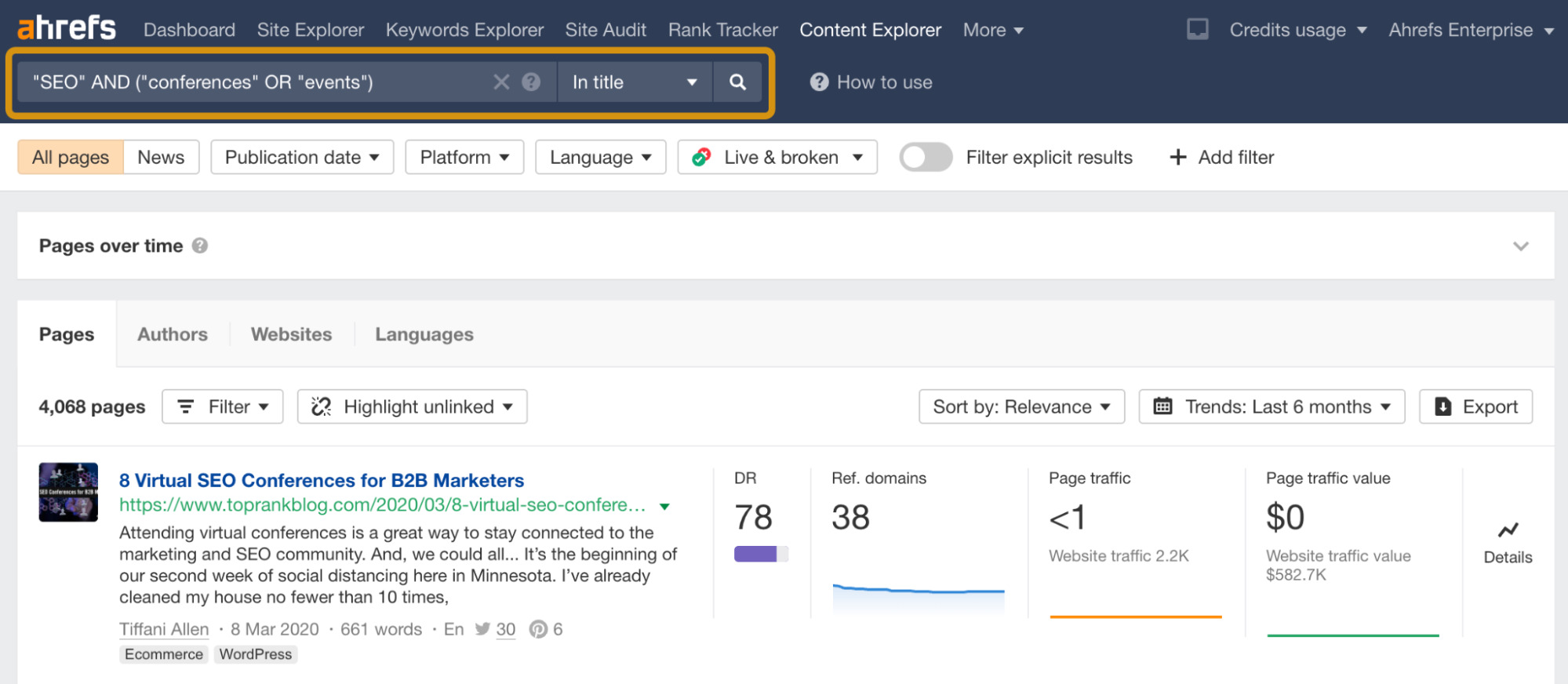
Toggle between “authors” and “websites” to find relevant people to reach out to.
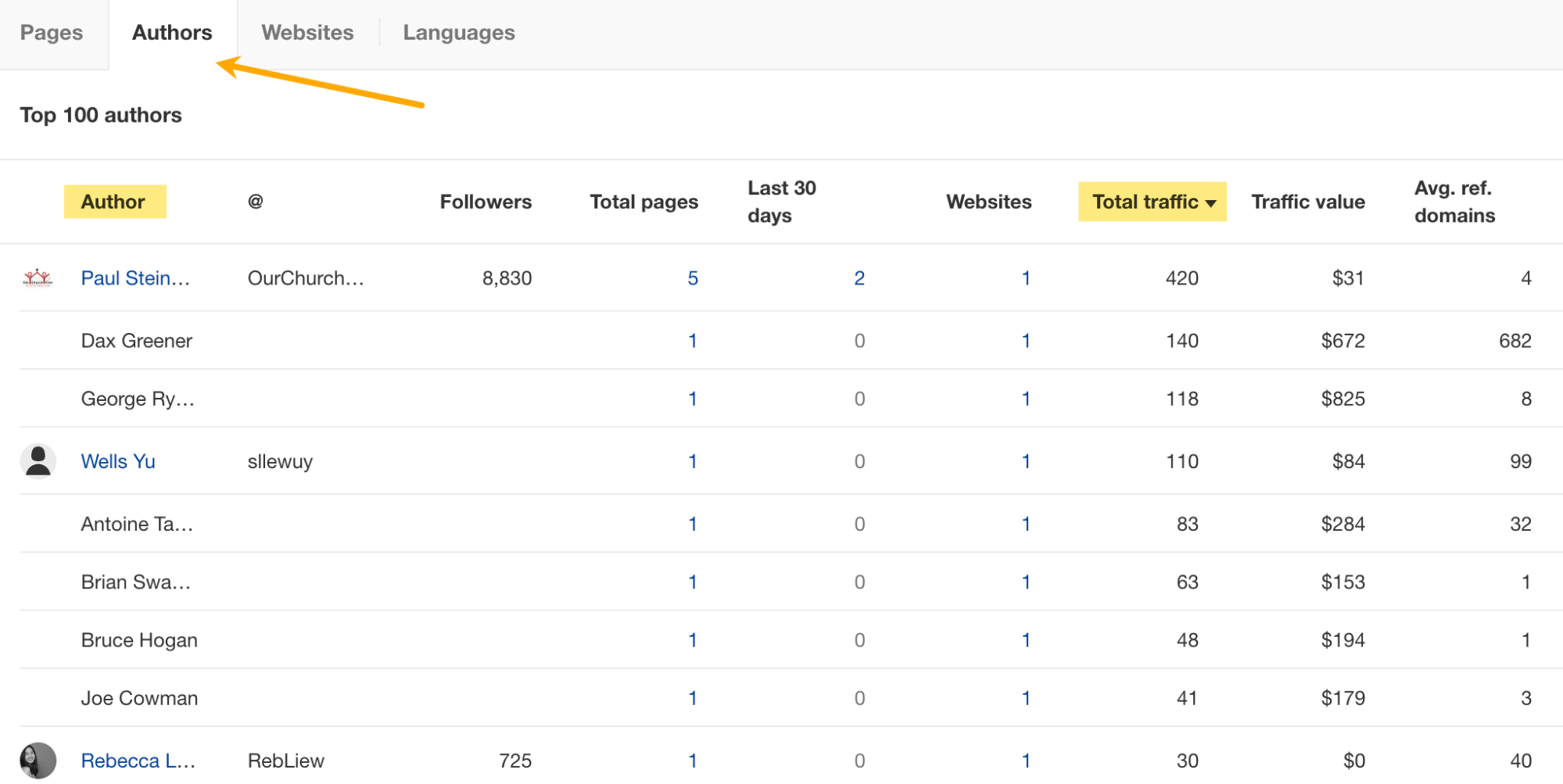
Tell people why they should share your event with a concise and clear personalized message. Links to event pages should be descriptive, and you should also explain why their readers will benefit from your event.
5. Promote your event further
You can take event promotion one step further in several ways. Not only can you utilize digital PR techniques, but you can also use social media to create more brand awareness and drive additional traffic to your event listings. These include:
- Creating Facebook events.
- Adding events’ links to your social profiles.
- Promoting your events through your email list.
All of these methods can successfully build some buzz around your event.
A teaser campaign is another great method of building buzz. This means adding a secondary event page on your website that can attract more links.
Using a “coming soon” landing page and social media graphics is one of the easiest and most popular ways to start a teaser campaign. Don’t tell too much, but point out the exciting things that will happen during the event.
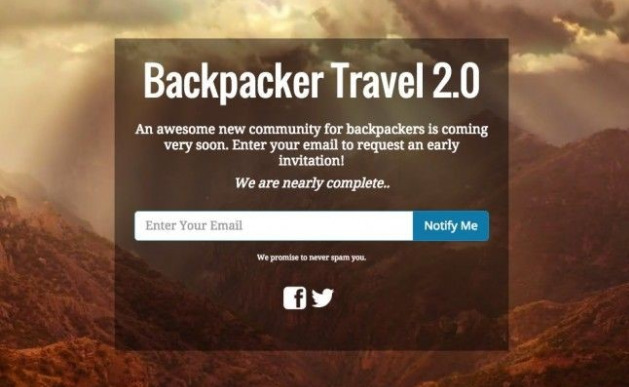
6. Use paid promotions close to the event
In the days leading up to your event, social media can work wonders to build buzz since many users check their newsfeeds daily. Getting more exposure for your event can be achieved through paid social media posts.
Although many attendees will #doitforthegram during the event, research from Buffer shows that “there were nearly as many posts leading up to an event as there were during the event itself 40% and 42% of total posts, respectively).”
This means just as many people will be keen to share the buzz around your event before it happens and when it actually happens. By building anticipation for your event in the days leading up to it, you can promote additional, last-minute ticket sales.
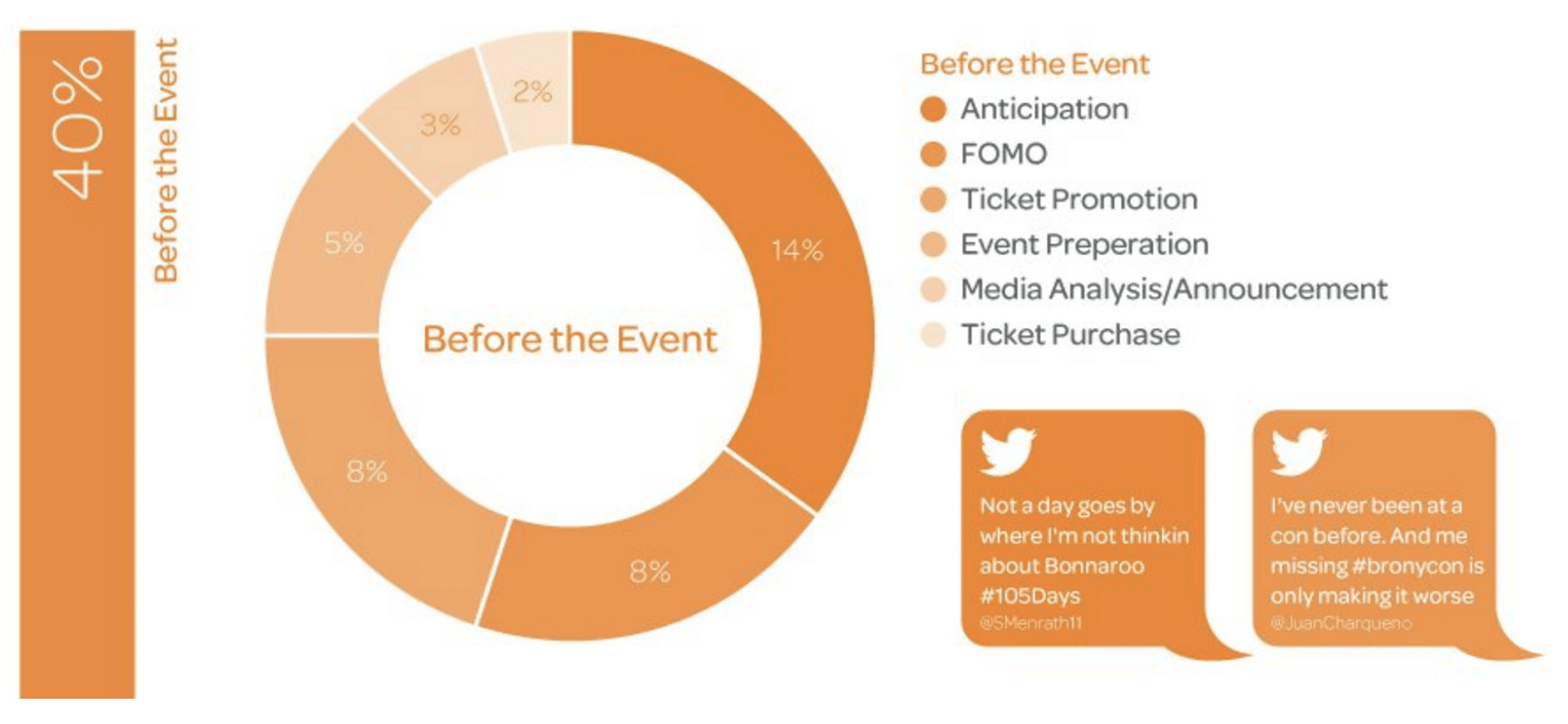
This number can be even higher by boosting organic social media buzz with paid ads and posts, resulting in more likes, shares, retweets, and links.
Final thoughts
Hosting and sponsoring local, national, and even global events is a relatively easy way to build high-quality backlinks. Plus, by hosting an event, you can build links that your competitors can’t easily replicate.
However, you must plan and execute your events carefully to build successful connections. By carefully selecting events to host and sponsor, you can build links, promote your brand, company message, and values, and become an authority within your industry.
Got questions? Ping me on Twitter.
SEO
How To Write ChatGPT Prompts To Get The Best Results

ChatGPT is a game changer in the field of SEO. This powerful language model can generate human-like content, making it an invaluable tool for SEO professionals.
However, the prompts you provide largely determine the quality of the output.
To unlock the full potential of ChatGPT and create content that resonates with your audience and search engines, writing effective prompts is crucial.
In this comprehensive guide, we’ll explore the art of writing prompts for ChatGPT, covering everything from basic techniques to advanced strategies for layering prompts and generating high-quality, SEO-friendly content.
Writing Prompts For ChatGPT
What Is A ChatGPT Prompt?
A ChatGPT prompt is an instruction or discussion topic a user provides for the ChatGPT AI model to respond to.
The prompt can be a question, statement, or any other stimulus to spark creativity, reflection, or engagement.
Users can use the prompt to generate ideas, share their thoughts, or start a conversation.
ChatGPT prompts are designed to be open-ended and can be customized based on the user’s preferences and interests.
How To Write Prompts For ChatGPT
Start by giving ChatGPT a writing prompt, such as, “Write a short story about a person who discovers they have a superpower.”
ChatGPT will then generate a response based on your prompt. Depending on the prompt’s complexity and the level of detail you requested, the answer may be a few sentences or several paragraphs long.
Use the ChatGPT-generated response as a starting point for your writing. You can take the ideas and concepts presented in the answer and expand upon them, adding your own unique spin to the story.
If you want to generate additional ideas, try asking ChatGPT follow-up questions related to your original prompt.
For example, you could ask, “What challenges might the person face in exploring their newfound superpower?” Or, “How might the person’s relationships with others be affected by their superpower?”
Remember that ChatGPT’s answers are generated by artificial intelligence and may not always be perfect or exactly what you want.
However, they can still be a great source of inspiration and help you start writing.
Must-Have GPTs Assistant
I recommend installing the WebBrowser Assistant created by the OpenAI Team. This tool allows you to add relevant Bing results to your ChatGPT prompts.
This assistant adds the first web results to your ChatGPT prompts for more accurate and up-to-date conversations.
It is very easy to install in only two clicks. (Click on Start Chat.)
For example, if I ask, “Who is Vincent Terrasi?,” ChatGPT has no answer.
With WebBrower Assistant, the assistant creates a new prompt with the first Bing results, and now ChatGPT knows who Vincent Terrasi is.
 Screenshot from ChatGPT, March 2023
Screenshot from ChatGPT, March 2023You can test other GPT assistants available in the GPTs search engine if you want to use Google results.
Master Reverse Prompt Engineering
ChatGPT can be an excellent tool for reverse engineering prompts because it generates natural and engaging responses to any given input.
By analyzing the prompts generated by ChatGPT, it is possible to gain insight into the model’s underlying thought processes and decision-making strategies.
One key benefit of using ChatGPT to reverse engineer prompts is that the model is highly transparent in its decision-making.
This means that the reasoning and logic behind each response can be traced, making it easier to understand how the model arrives at its conclusions.
Once you’ve done this a few times for different types of content, you’ll gain insight into crafting more effective prompts.
Prepare Your ChatGPT For Generating Prompts
First, activate the reverse prompt engineering.
- Type the following prompt: “Enable Reverse Prompt Engineering? By Reverse Prompt Engineering I mean creating a prompt from a given text.”
 Screenshot from ChatGPT, March 2023
Screenshot from ChatGPT, March 2023ChatGPT is now ready to generate your prompt. You can test the product description in a new chatbot session and evaluate the generated prompt.
- Type: “Create a very technical reverse prompt engineering template for a product description about iPhone 11.”
 Screenshot from ChatGPT, March 2023
Screenshot from ChatGPT, March 2023The result is amazing. You can test with a full text that you want to reproduce. Here is an example of a prompt for selling a Kindle on Amazon.
- Type: “Reverse Prompt engineer the following {product), capture the writing style and the length of the text :
product =”
 Screenshot from ChatGPT, March 2023
Screenshot from ChatGPT, March 2023I tested it on an SEJ blog post. Enjoy the analysis – it is excellent.
- Type: “Reverse Prompt engineer the following {text}, capture the tone and writing style of the {text} to include in the prompt :
text = all text coming from https://www.searchenginejournal.com/google-bard-training-data/478941/”
 Screenshot from ChatGPT, March 2023
Screenshot from ChatGPT, March 2023But be careful not to use ChatGPT to generate your texts. It is just a personal assistant.
Go Deeper
Prompts and examples for SEO:
- Keyword research and content ideas prompt: “Provide a list of 20 long-tail keyword ideas related to ‘local SEO strategies’ along with brief content topic descriptions for each keyword.”
- Optimizing content for featured snippets prompt: “Write a 40-50 word paragraph optimized for the query ‘what is the featured snippet in Google search’ that could potentially earn the featured snippet.”
- Creating meta descriptions prompt: “Draft a compelling meta description for the following blog post title: ’10 Technical SEO Factors You Can’t Ignore in 2024′.”
Important Considerations:
- Always Fact-Check: While ChatGPT can be a helpful tool, it’s crucial to remember that it may generate inaccurate or fabricated information. Always verify any facts, statistics, or quotes generated by ChatGPT before incorporating them into your content.
- Maintain Control and Creativity: Use ChatGPT as a tool to assist your writing, not replace it. Don’t rely on it to do your thinking or create content from scratch. Your unique perspective and creativity are essential for producing high-quality, engaging content.
- Iteration is Key: Refine and revise the outputs generated by ChatGPT to ensure they align with your voice, style, and intended message.
Additional Prompts for Rewording and SEO:
– Rewrite this sentence to be more concise and impactful.
– Suggest alternative phrasing for this section to improve clarity.
– Identify opportunities to incorporate relevant internal and external links.
– Analyze the keyword density and suggest improvements for better SEO.
Remember, while ChatGPT can be a valuable tool, it’s essential to use it responsibly and maintain control over your content creation process.
Experiment And Refine Your Prompting Techniques
Writing effective prompts for ChatGPT is an essential skill for any SEO professional who wants to harness the power of AI-generated content.
Hopefully, the insights and examples shared in this article can inspire you and help guide you to crafting stronger prompts that yield high-quality content.
Remember to experiment with layering prompts, iterating on the output, and continually refining your prompting techniques.
This will help you stay ahead of the curve in the ever-changing world of SEO.
More resources:
Featured Image: Tapati Rinchumrus/Shutterstock
SEO
Measuring Content Impact Across The Customer Journey

Understanding the impact of your content at every touchpoint of the customer journey is essential – but that’s easier said than done. From attracting potential leads to nurturing them into loyal customers, there are many touchpoints to look into.
So how do you identify and take advantage of these opportunities for growth?
Watch this on-demand webinar and learn a comprehensive approach for measuring the value of your content initiatives, so you can optimize resource allocation for maximum impact.
You’ll learn:
- Fresh methods for measuring your content’s impact.
- Fascinating insights using first-touch attribution, and how it differs from the usual last-touch perspective.
- Ways to persuade decision-makers to invest in more content by showcasing its value convincingly.
With Bill Franklin and Oliver Tani of DAC Group, we unravel the nuances of attribution modeling, emphasizing the significance of layering first-touch and last-touch attribution within your measurement strategy.
Check out these insights to help you craft compelling content tailored to each stage, using an approach rooted in first-hand experience to ensure your content resonates.
Whether you’re a seasoned marketer or new to content measurement, this webinar promises valuable insights and actionable tactics to elevate your SEO game and optimize your content initiatives for success.
View the slides below or check out the full webinar for all the details.
SEO
How to Find and Use Competitor Keywords

Competitor keywords are the keywords your rivals rank for in Google’s search results. They may rank organically or pay for Google Ads to rank in the paid results.
Knowing your competitors’ keywords is the easiest form of keyword research. If your competitors rank for or target particular keywords, it might be worth it for you to target them, too.
There is no way to see your competitors’ keywords without a tool like Ahrefs, which has a database of keywords and the sites that rank for them. As far as we know, Ahrefs has the biggest database of these keywords.
How to find all the keywords your competitor ranks for
- Go to Ahrefs’ Site Explorer
- Enter your competitor’s domain
- Go to the Organic keywords report
The report is sorted by traffic to show you the keywords sending your competitor the most visits. For example, Mailchimp gets most of its organic traffic from the keyword “mailchimp.”


Since you’re unlikely to rank for your competitor’s brand, you might want to exclude branded keywords from the report. You can do this by adding a Keyword > Doesn’t contain filter. In this example, we’ll filter out keywords containing “mailchimp” or any potential misspellings:


If you’re a new brand competing with one that’s established, you might also want to look for popular low-difficulty keywords. You can do this by setting the Volume filter to a minimum of 500 and the KD filter to a maximum of 10.


How to find keywords your competitor ranks for, but you don’t
- Go to Competitive Analysis
- Enter your domain in the This target doesn’t rank for section
- Enter your competitor’s domain in the But these competitors do section


Hit “Show keyword opportunities,” and you’ll see all the keywords your competitor ranks for, but you don’t.


You can also add a Volume and KD filter to find popular, low-difficulty keywords in this report.


How to find keywords multiple competitors rank for, but you don’t
- Go to Competitive Analysis
- Enter your domain in the This target doesn’t rank for section
- Enter the domains of multiple competitors in the But these competitors do section


You’ll see all the keywords that at least one of these competitors ranks for, but you don’t.


You can also narrow the list down to keywords that all competitors rank for. Click on the Competitors’ positions filter and choose All 3 competitors:


- Go to Ahrefs’ Site Explorer
- Enter your competitor’s domain
- Go to the Paid keywords report


This report shows you the keywords your competitors are targeting via Google Ads.
Since your competitor is paying for traffic from these keywords, it may indicate that they’re profitable for them—and could be for you, too.
You know what keywords your competitors are ranking for or bidding on. But what do you do with them? There are basically three options.
1. Create pages to target these keywords
You can only rank for keywords if you have content about them. So, the most straightforward thing you can do for competitors’ keywords you want to rank for is to create pages to target them.
However, before you do this, it’s worth clustering your competitor’s keywords by Parent Topic. This will group keywords that mean the same or similar things so you can target them all with one page.
Here’s how to do that:
- Export your competitor’s keywords, either from the Organic Keywords or Content Gap report
- Paste them into Keywords Explorer
- Click the “Clusters by Parent Topic” tab


For example, MailChimp ranks for keywords like “what is digital marketing” and “digital marketing definition.” These and many others get clustered under the Parent Topic of “digital marketing” because people searching for them are all looking for the same thing: a definition of digital marketing. You only need to create one page to potentially rank for all these keywords.


2. Optimize existing content by filling subtopics
You don’t always need to create new content to rank for competitors’ keywords. Sometimes, you can optimize the content you already have to rank for them.
How do you know which keywords you can do this for? Try this:
- Export your competitor’s keywords
- Paste them into Keywords Explorer
- Click the “Clusters by Parent Topic” tab
- Look for Parent Topics you already have content about
For example, if we analyze our competitor, we can see that seven keywords they rank for fall under the Parent Topic of “press release template.”


If we search our site, we see that we already have a page about this topic.


If we click the caret and check the keywords in the cluster, we see keywords like “press release example” and “press release format.”


To rank for the keywords in the cluster, we can probably optimize the page we already have by adding sections about the subtopics of “press release examples” and “press release format.”
3. Target these keywords with Google Ads
Paid keywords are the simplest—look through the report and see if there are any relevant keywords you might want to target, too.
For example, Mailchimp is bidding for the keyword “how to create a newsletter.”


If you’re ConvertKit, you may also want to target this keyword since it’s relevant.
If you decide to target the same keyword via Google Ads, you can hover over the magnifying glass to see the ads your competitor is using.


You can also see the landing page your competitor directs ad traffic to under the URL column.


Learn more
Check out more tutorials on how to do competitor keyword analysis:
-

 PPC5 days ago
PPC5 days ago19 Best SEO Tools in 2024 (For Every Use Case)
-
SEARCHENGINES7 days ago
Daily Search Forum Recap: April 17, 2024
-
SEARCHENGINES6 days ago
Daily Search Forum Recap: April 18, 2024
-
SEARCHENGINES5 days ago
Daily Search Forum Recap: April 19, 2024
-

 MARKETING6 days ago
MARKETING6 days agoEcommerce evolution: Blurring the lines between B2B and B2C
-

 SEO6 days ago
SEO6 days ago2024 WordPress Vulnerability Report Shows Errors Sites Keep Making
-

 WORDPRESS5 days ago
WORDPRESS5 days agoHow to Make $5000 of Passive Income Every Month in WordPress
-

 WORDPRESS6 days ago
WORDPRESS6 days ago10 Amazing WordPress Design Resouces – WordPress.com News














